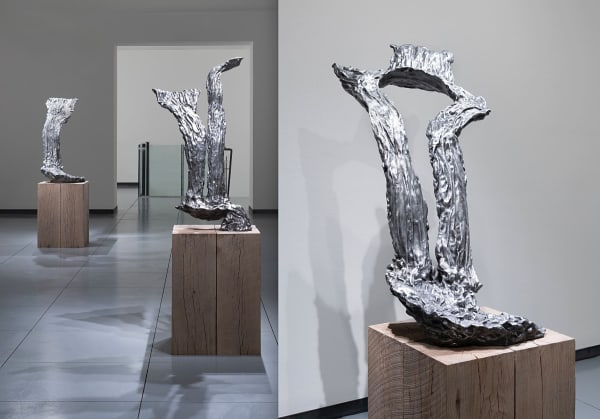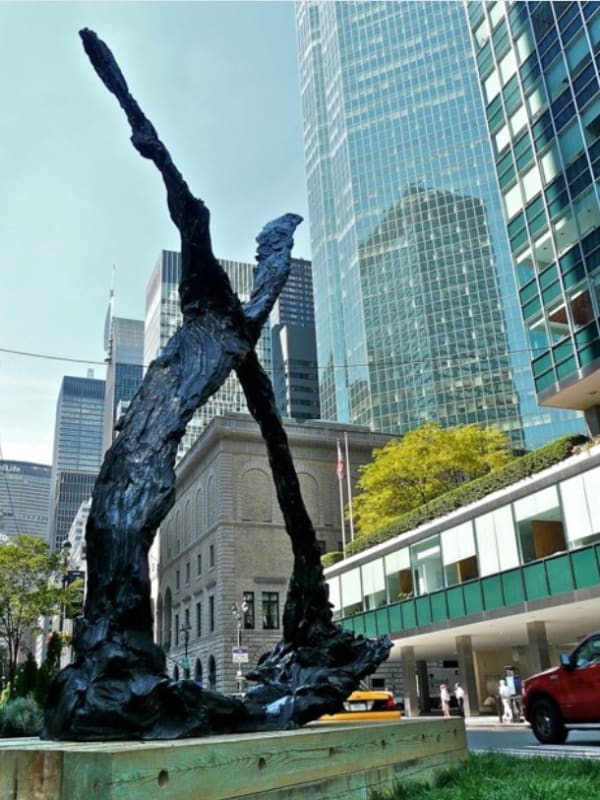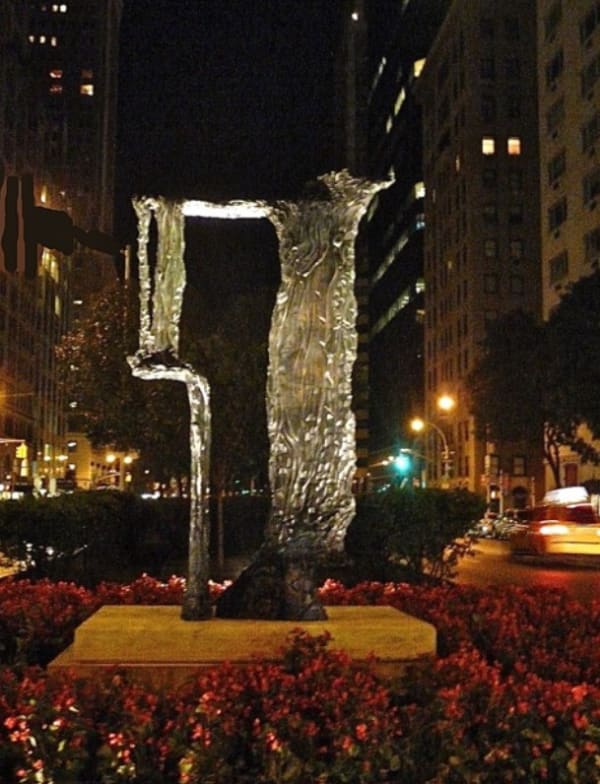Bryan Hunt USA, b. 1947
"I was looking at conceptual art and earthworks. I thought, Why not work with scale and interpretation and build monuments like the Empire State Building or Hoover Dam? Why not think of the Hoover Dam as an earthwork and put it in a studio space so the scale is shifted and a bit dada? It was edgy because it was going back to object-making via conceptual art and, dare I say, the anarchy of tradition—like working in bronze and modeling clay. I guess you could say it was post-minimal."
Bryan Hunt (b. 1947 in Terre Haute, IN) developed an early interest in architecture and space exploration having worked as a technical assistant at the Kennedy Space Center and later as a draftsman for a mechanical engineer.
In 1968, Hunt moved to Los Angeles and studied at the Otis Art Institute. He continued to live and work in LA until 1976, part of a dynamic scene that included Allan McCollum, Lynda Benglis, Bruce Naumann, and Chris Burden.
During these years in LA, Hunt produced an extraordinary body of work. Curator Sue Scott has called 1974 the pivotal year of Hunt's career. "In only twelve months, he created five important sculptures that moved his work in a new direction, laying a firm foundation for years of intense creativity. These five works - Empire State with Hindenburg, Nankow Pass (Wall of China), Hoover Dam, Tower of Babel, and the first of a series of airships - with their curious amalgamation of art, science, technology and philosophy were radically different from sculpture then being shown in galleries and museums".
Bryan Hunt's most iconic bodies of works are the Airships which he developed thanks to his interest in architecture and space. These dirigible-shaped structures are mounted directly into the wall over the viewer's head and out of reach, giving the impression of being suspended in space. Hunt has revisited the airship shape frequently since the 1970s. These works were a challenge to the cult-like followers of Minimalism and Earth Art and a sophisticated and idiosyncratic response to classical and modern sculpture. Following these earliest works came a series of sculptures depicting the volumes of lakes and quarries and then the first of his signature waterfall sculptures. Christoph Brockhaus noted that Hunt "has been interested in Rodin's surface structure, Brancusi's dialogue between sculpture and pedestal, the geometric shapes of Constructivism, and Abstract Expressionisms gesture".
Bryan Hunt lives and works in New York City. He has exhibited in several museums and institutions including; The Institute for Art and Urban Resources, The Clocktower, New York (1974), "Young American Artists" at The Solomon R. Guggenheim Museum (1978), "made by sculptors" at the Stedelijk Museum, Amsterdam (1978), "Decade in Review" at the Whitney Museum of American Art (1979), and "Visionary Images" Renaissance Society at the University of Chicago (1979). His work is included in museum collections, including the Museum of Modern Art, New York; the Whitney Museum of American Art, New York; the Hirshhorn Museum and Sculpture Garden, Washington; the Los Angeles County Museum of Art; and the Museum of Contemporary Art, Los Angeles.
-
 Bryan HuntSmall Silver U, 2009casta aqua resin34 x 24 x 18 cm
Bryan HuntSmall Silver U, 2009casta aqua resin34 x 24 x 18 cm -
 Bryan HuntMigration ll - (vertical) Pod Vl , 2024urethane, flashe paint, metal leafingoverall installation 270 x 121.9 x 33 cm - 13 elements 15 x 33 x 15 cm each
Bryan HuntMigration ll - (vertical) Pod Vl , 2024urethane, flashe paint, metal leafingoverall installation 270 x 121.9 x 33 cm - 13 elements 15 x 33 x 15 cm each -
 Bryan HuntReclining Venus, 2011aqua resin and acrylicH 61 x W 53 x L 44 cm
Bryan HuntReclining Venus, 2011aqua resin and acrylicH 61 x W 53 x L 44 cm -
 Bryan HuntOrville, 2012gold leaf, acqua resin and acrylic paint on balsa woodH 27 x W 22 x L 127 cm
Bryan HuntOrville, 2012gold leaf, acqua resin and acrylic paint on balsa woodH 27 x W 22 x L 127 cm -
 Bryan HuntBlue Venus, 2012aqua-resin, urethane, maple wood
Bryan HuntBlue Venus, 2012aqua-resin, urethane, maple wood
H 100 x W 37 x L 40 cm -
 Bryan HuntBlack U Ship, 2009-2010urethane, graphite and steelH 21 x W 100 x L 75 cm
Bryan HuntBlack U Ship, 2009-2010urethane, graphite and steelH 21 x W 100 x L 75 cm
-
 Bryan HuntCopper U Study, 2009casta aqua resin - edition of 340.5 x 25.4 x 12.5 cm
Bryan HuntCopper U Study, 2009casta aqua resin - edition of 340.5 x 25.4 x 12.5 cm -
 Bryan HuntMigration I - Pod V , 2024urethane, flashe paint, metal leafingoverall installation 177.8 x 91.4 x 33 cm - 12 elements 15 x 33 x 15 cm each
Bryan HuntMigration I - Pod V , 2024urethane, flashe paint, metal leafingoverall installation 177.8 x 91.4 x 33 cm - 12 elements 15 x 33 x 15 cm each
-
 Bryan HuntCeta Blues, 2023cast aqua-resin and flashe paintH 57 x W 60 x L 103 cm
Bryan HuntCeta Blues, 2023cast aqua-resin and flashe paintH 57 x W 60 x L 103 cm
-

Non comune, quasi soprannaturale: la prima di Bryan Hunt a Bergamo
REVIEW | Exibart December 4, 2024 Read more -

Bryan Hunt - group show "Couples Squared"
Southamptons Arts Center, Southampton, USA July 27, 2024 Read more -

Bryan Hunt in conversation with Justin Gunther
Fallingwater Fireside, Western Pennsylvania Conservancy January 24, 2024FALLINGWATER FIRESIDE: Carrying on the Kaufmann family’s tradition, Fallingwater invites special guests for intimate discussions that advance ideas around architecture, art, design and nature. Join...Read more -

Bryan Hunt
Baldwin Gallery, Aspen, USA December 26, 2023 Read more -

Bryan Hunt - Lunarium
Art Center Duck Creek, East Hampton, NY, USA July 11, 2020The Arts Center at Duck Creek is pleased to announce Lunarium featuring paintings by artist Bryan Hunt. This exhibition will open to the public on...Read more -

Bryan Hunt - Grand Canyon Paintings and Space Orbs
Baldwin Gallery, Aspen, CO, USA February 13, 2020 Read more -

Bryan Hunt
Interview | BOMB MAGAZINE March 15, 2017 Read more -

Bryan Hunt - Recalculating
Danese Corey Gallery, New York, NY, USA April 20, 2012 Read more -

Bryan Hunt
Park Avenue, New York City, NY, USA October 29, 2011MORE INFO HERE !Read more -

Bryan Hunt - Park Avenue Cascades: Q+A With Bryan Hunt
Review - ART IN AMERICA October 11, 2011 Read more -

Bryan Hunt
Locks Gallery, Philadelphia, PA, USA September 14, 2007 Read more -

Bryan Hunt
Locks Gallery, Philadelphia, PA, USA March 1, 2002 Read more























